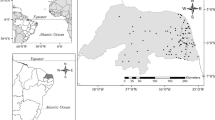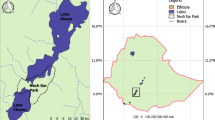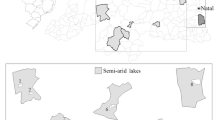Abstract
Limnology has traditionally been a science of temperate regions. Long-term studies are not common in tropical regions despite the number of large tropical lakes that constitute a significant proportion of global freshwater resources. A number of comparative studies have shown that tropical lakes are different from temperate lakes in some fundamental ways. Constantly high temperature and radiation have strong consequences for stratification and biological processes. Previous studies suggested that higher primary production on a given nutrient base in tropical lakes is related to their higher decomposition rates. Moreover, lower efficiency in transforming primary production to higher trophic levels in tropical lakes also has been postulated as a difference. Data on the microbial processes in tropical lakes are scarce, but fail showing any significant difference in epilimnetic decomposition (bacterial) processes between temperate and tropical aquatic systems. The most significant differences found so far are in autotrophic and consumer community composition and body size, which constrain the upper compartments of the food web in a deterministic way. The reconciliation of ecological theory and observations yields a conceptual framework that illustrates likely structural variations in food webs along the latitudinal gradient.








Similar content being viewed by others
References
Anesio, A. M., P. C. Abreu & F. D. Esteves, 1997. Influence of the hydrological cycle on the bacterioplankton of an impacted clear water Amazonian lake. Microbial Ecology 34: 66–73.
Azam, F., T. Fenchel, J. G. Field, J. S. Gray, L. A. Meyerreil & F. Thingstad, 1983. The ecological role of water-column microbes in the sea. Marine Ecology Progress Series 10: 257–263.
Barros, N., J. J. Cole, L. J. Tranvik, Y. T. Prairie, D. Bastviken, V. L. M. Huszar, P. Del Giorgio & F. Roland, 2011. Carbon emission from hydroelectric reservoirs linked to reservoir age and latitude. Nature Geoscience 4: 593–596.
Beadle, L. C., 1981. The Inland Waters of Tropical Africa – An Introduction to Tropical Limnology. Longman, New York.
Belykh, O., G. Ekaterina, T. Sorokovikova, A. Saphonova & I. Tikhonova, 2006. Autotrophic picoplankton of Lake Baikal: composition, abundance and structure. Hydrobiologia 568: 9–17.
Bouvy, M., R. Arfi, P. Cecchi, D. Corbin, M. Pagano, L. Saint-Jean & S. Thomas, 1998. Trophic coupling between bacterial and phytoplanktonic compartments in shallow tropical reservoirs (Ivory Coast, West Africa). Aquatic Microbial Ecology 15: 25–37.
Bouvy, M., Y. Bettarel, C. Bouvier, I. Domaizon, S. Jacquet, E. Le Floc’h, H. Montanié, B. Mostajir, T. Sime-Ngando, J. P. Torréton, F. Vidussi & T. Bouvier, 2011. Trophic interactions between viruses, bacteria and nanoflagellates under various nutrient conditions and simulated climate change. Environmental Microbiology 13: 1842–1857.
Brown, J. H., J. F. Gillooly, A. P. Allen, V. M. Savage & G. B. West, 2004. Toward a metabolic theory of ecology. Ecology 85: 1771–1789.
Burgis, M. J., 1971. The ecology and production of copepods, particularly Thermocyclops hyalinus, in the tropical Lake George, Uganda. Freshwater Biology 1: 169–192.
Callieri, C., 2008. Picophytoplankton in freshwater ecosystems: the importance of small-sized phototrophs. Freshwater Reviews 1: 1–28.
Callieri, C., 2010. Single cells and microcolonies of freshwater picocyanobacteria: a common ecology. Journal of Limnology 69: 257–277.
Callieri, C. & J. G. Stockner, 2002. Freshwater autotrophic picoplankton: a review. Journal of Limnology 61: 1–14.
Carlson, C. A., P. A. Del Giorgio & G. J. Herndl, 2007. Microbes and the dissipation of energy and respiration: from cells to ecosystems. Oceanography 20: 89–100.
Carrick, H. J., G. L. Fahnenstiel, E. F. Stoermer & R. G. Wetzel, 1991. The importance of zooplankton-protozoan trophic couplings in Lake-Michigan. Limnology and Oceanography 36: 1335–1345.
Castillo, M. M., 2000. Influence of hydrological seasonality on bacterioplankton in two neotropical floodplain lakes. Hydrobiologia 437: 57–69.
Cole, J. J., S. Findlay & M. L. Pace, 1988. Bacterial production in fresh and saltwater ecosystems – a cross-system overview. Marine Ecology Progress Series 43: 1–10.
Currie, D. J., 1990. Large-scale variability and interactions among phytoplankton, bacterioplankton, and phosphorus. Limnology and Oceanography 35: 1437–1455.
Descy, J. P. & H. Sarmento, 2008. Microorganisms of the East African Great Lakes and their response to environmental changes. Freshwater Reviews 1: 59–73.
Descy, J.-P., M.-A. Hardy, S. Sténuite, S. Pirlot, B. Leporcq, I. Kimirei, B. Sekadende, S. Mwaitega & D. Sinyenza, 2005. Phytoplankton pigments and community composition in Lake Tanganyika. Freshwater Biology 50: 668–684.
Erikson, R., E. Hooker, M. Mejia, A. Zelaya & K. Vammen, 1998a. Optimal conditions for primary production in a polymictic tropical lake (Lake Xolotlan, Nicaragua). Hydrobiologia 382: 1–16.
Erikson, R., K. Vammen, A. Zelaya & R. T. Bell, 1998b. Distribution and dynamics of bacterioplankton production in a polymictic tropical lake (Lago Xolotlan, Nicaragua). Hydrobiologia 382: 27–39.
Farjalla, V., A. Amado, A. Suhett & F. Meirelles-Pereira, 2009. DOC removal paradigms in highly humic aquatic ecosystems. Environmental Science and Pollution Research 16: 531–538.
Fernando, C. H., 1994. Zooplankton, fish and fisheries in tropical fresh-waters. Hydrobiologia 272: 105–123.
Gasol, J. M., A. M. Simons & J. Kalff, 1995. Patterns in the top-down versus bottom-up regulation of heterotrophic nanoflagellates in temperate lakes. Journal of Plankton Research 17: 1879–1903.
Gasol, J. M., J. Pinhassi, L. Alonso-Sáez, H. Ducklow, G. J. Herndl, M. Koblizek, M. Labrenz, Y. Luo, X. A. G. Morán, T. Reinthaler & M. Simon, 2008. Towards a better understanding of microbial carbon flux in the sea. Aquatic Microbial Ecology 53: 21–38.
Hecky, R. E., 2000. A biogeochemical comparison of Lakes Superior and Malawi and the limnological consequences of an endless summer. Aquatic Ecosystem Health and Management 3: 23–33.
Hecky, R. E. & E. J. Fee, 1981. Primary production and rates of algal growth in Lake Tanganyika. Limnology and Oceanography 26: 532–547.
Hobbie, J. E., R. J. Daley & S. Jasper, 1977. Use of nuclepore filters for counting bacteria by fluorescence microscopy. Applied and Environmental Microbiology 33: 1225–1228.
Irvine, K. & R. Waya, 1999. Spatial and temporal patterns of zooplankton standing biomass and production in Lake Malawi. Hydrobiologia 407: 191–205.
Jake Vander Zanden, M. & W. W. Fetzer, 2007. Global patterns of aquatic food chain length. Oikos 116: 1378–1388.
Kilham, S. S. & P. Kilham, 1990. Endless summer: internal loading processes dominate nutrient cycling in tropical lakes. Freshwater Biology 23: 379–389.
Kirchman, D., E. K’nees & R. Hodson, 1985. Leucine incorporation and its potential as a measure of protein synthesis by bacteria in natural aquatic systems. Applied and Environmental Microbiology 49: 599–607.
Lee, C. W. & C. W. Bong, 2008. Bacterial abundance and production, and their relation to primary production in tropical coastal waters of Peninsular Malaysia. Marine and Freshwater Research 59: 10–21.
Lehner, B. & P. Döll, 2004. Development and validation of a global database of lakes, reservoirs and wetlands. Journal of Hydrology 296: 1–22.
Lewis, W. M. J., 1974. Primary production in the plankton community of a tropical lake. Ecological Monographs 44: 377–409.
Lewis, W. M. J., 1976. Surface/volume ratio: implications for phytoplankton morphology. Science 192: 885–887.
Lewis, W. M. J., 1987. Tropical limnology. Annual Review of Ecology and Systematics 18: 159–184.
Lewis, W. M. J., 1990. Comparisons of phytoplankton biomass in temperate and tropical lakes. Limnology and Oceanography 35: 1838–1845.
Lewis, W. M. J., 1996. Tropical lakes: how latitude makes a difference. In Perspectives in Tropical Limnology. SPB, Amsterdam: 43–64.
Lewis, W. M. J., 2000. Basis for the protection and management of tropical lakes. Lakes & Reservoirs: Research and Management 5: 35–48.
Lewis, W. M. J., 2010. Biogeochemistry of tropical lakes. In J. Jones (ed.), International Association of Theoretical and Applied Limnology, Vol. 30, Pt. 10, Proceedings, Montreal, Canada: 1595–1603.
Lewis, W. M. J., T. Frost & D. Morris, 1986. Studies of planktonic bacteria in Lake Valencia, Venezuela. Archiv für Hydrobiologie 106: 289–305.
Lind, O. T., T. H. Chrzanowski & L. Davalos-Lind, 1997. Clay turbidity and the relative production of bacterioplankton and phytoplankton. Hydrobiologia 353: 1–18.
Lindell, M. & H. Edling, 1996. Influence of light on bacterioplankton in a tropical lake. Hydrobiologia 323: 67–73.
López-Urrutia, A. & Xa. G. Morán, 2007. Resource limitation of bacterial production distorts the temperature dependence of oceanic carbon cycling. Ecology 88: 817–822.
López-Urrutia, Á., E. San Martin, R. P. Harris & X. Irigoien, 2006. Scaling the metabolic balance of the oceans. Proceedings of the National Academy of Sciences of the United States of America 103: 8739–8744.
Maurice, C. F., D. Mouillot, Y. Bettarel, R. De Wit, H. Sarmento & T. Bouvier, 2010. Disentangling the relative influence of bacterioplankton phylogeny and metabolism on lysogeny in reservoirs and lagoons. ISME Journal 5(5): 831–842.
Melack, J. M., 1979. Temporal variability of phytoplankton in tropical lakes. Oecologia 44: 1–7.
Mengestou, S. & C. H. Fernando, 1991. Biomass and production of the major dominant crustacean zooplankton in a tropical Rift Valley lake, Awasa, Ethiopia. Journal of Plankton Research 13: 831–851.
Morris, D. P. & W. M. Lewis, 1992. Nutrient limitation of bacterioplankton growth in lake Dillon, Colorado. Limnology and Oceanography 37: 1179–1192.
Moutin, T., F. T. Tron, F. V. Wambeke, D. Marie, G. Slawyk, P. Raimbault & H. Claustre, 2002. Does competition for nanomolar phosphate supply explain the predominance of the Cyanobacterium Synechococcus? Limnology and Oceanography 47: 1562–1567.
Nagata, T., K. Takai, K. Kawabata, M. Nakanishi & J. Urabe, 1996. The trophic transfer via a picoplankton-flagellate-copepod food chain during a picocyanobacterial bloom in Lake Biwa. Archiv für Hydrobiologie 137: 145–160.
Ngochera, M. J. & H. A. Bootsma, 2011. Temporal trends of phytoplankton and zooplankton stable isotope composition in tropical Lake Malawi. Journal of Great Lakes Research 37: 45–53.
Pace, M. L., G. B. Mcmanus & S. E. G. Findlay, 1990. Planktonic community structure determines the fate of bacterial production in a temperate lake. Limnology and Oceanography 35: 795–808.
Peel, M. C., B. L. Finlayson & T. A. Mcmahon, 2007. Updated world map of the Köppen-Geiger climate classification. Hydrology and Earth System Sciences 11: 1633–1644.
Pernthaler, J., K. Simek, B. Sattler, A. Schwarzenbacher, J. Bobkova & R. Psenner, 1996. Short-term changes of protozoan control on autotrophic picoplankton in an oligo-mesotrophic lake. Journal of Plankton Research 18: 443–462.
Petrucio, M. M., Fa. R. Barbosa & A. L. S. Furtado, 2006. Bacterioplankton and phytoplankton production in seven lakes in the Middle Rio Doce basin, south-east Brazil. Limnologica 36: 192–203.
Pirlot, S., F. Unrein, J. P. Descy & P. Servais, 2007. Fate of heterotrophic bacteria in Lake Tanganyika (East Africa). FEMS Microbiology Ecology 62: 354–364.
Porter, K. G. & Y. S. Feig, 1980. The use of DAPI for identifying and counting aquatic microflora. Limnology and Oceanography 25: 943–948.
Post, D. M., 2002. The long and short of food-chain length. Trends in Ecology & Evolution 17: 269–277.
Post, D. M. & G. Takimoto, 2007. Proximate structural mechanisms for variation in food-chain length. Oikos 116: 775–782.
Post, D. M., M. L. Pace & N. G. Hairston, 2000. Ecosystem size determines food-chain length in lakes. Nature 405: 1047–1049.
Rejas, D., K. Muylaert & L. De Meester, 2005. Phytoplankton–bacterioplankton interactions in a neotropical floodplain lake (Laguna Bufeos, Bolivia). Hydrobiologia 543: 91–99.
Reynolds, C. S., 2006. The Ecology of Phytoplankton. Cambridge University Press, Cambridge.
Reynolds, C. S., S. N. Reynolds, I. F. Munawar & M. Munawar, 2000. The regulation of phytoplankton population dynamics in the world’s largest lakes. Aquatic Ecosystem Health and Management 3: 1–22.
Riemann, B. & K. Christoffersen, 1993. Microbial trophodynamics in temperate lakes. Marine Microbial Food Webs 7: 69–100.
Roland, F., L. M. Lobão, L. O. Vidal, E. Jeppesen, R. Paranhos & V. L. M. Huszar, 2010. Relationships between pelagic bacteria and phytoplankton abundances in contrasting tropical freshwaters. Aquatic Microbial Ecology 60: 261–272.
Sarmento, H., M. Isumbisho, S. Stenuite, F. Darchambeau, B. Leporcq & J. P. Descy, 2009. Phytoplankton ecology of Lake Kivu (eastern Africa): biomass, production and elemental ratios. In International Association of Theoretical and Applied Limnology, Vol. 30(Pt 5), Proceedings, Stuttgart, Germany: 709–713.
Sarmento, H., F. Darchambeau & J. P. Descy, in press. Phytoplankton. In Descy, J. P., F. Darchambeau & M. Schmid (eds), Lake Kivu: Limnology and Geochemistry of a Unique Tropical Great Lake. Aquatic Ecology Series. Springer.
Sarmento, H., M. Isumbisho & J. P. Descy, 2006. Phytoplankton ecology of Lake Kivu (eastern Africa). Journal of Plankton Research 28: 815–829.
Sarmento, H., M. Leitao, M. Stoyneva, A. Couté, P. Compère, M. Isumbisho & J. P. Descy, 2007. Species diversity of pelagic algae in Lake Kivu (East Africa). Cryptogamie-Algologie 28(245): 269.
Sarmento, H., F. Unrein, M. Isumbisho, S. Stenuite, J. M. Gasol & J. P. Descy, 2008. Abundance and distribution of picoplankton in tropical, oligotrophic Lake Kivu, eastern Africa. Freshwater Biology 53: 756–771.
Sarmento, H., J. M. Montoya, E. Váquez-Domínguez, D. Vaqué & J. M. Gasol, 2010. Warming effects on marine microbial food web processes: how far can we go when it comes to predictions? Philosophical Transactions of the Royal Society B: Biological Sciences 365: 2137–2149.
Sarvala, J., K. Salonen, M. Jarvinen, E. Aro, T. Huttula, P. Kotilainen, H. Kurki, V. Langenberg, P. Mannini, A. Peltonen, P. D. Plisnier, I. Vuorinen, H. Molsa & O. V. Lindqvist, 1999. Trophic structure of Lake Tanganyika: carbon flows in the pelagic food web. Hydrobiologia 407: 149–173.
Saunders, J. F. & W. M. Lewis, 1988. Dynamics and control mechanisms in a tropical zooplankton community (Lake Valencia, Venezuela). Ecological Monographs 58: 337–353.
Shapiro, H. M., 1995. Practical Flow Cytometry, 3rd edn. Wiley-Liss, New York.
Sherr, E. & B. Sherr, 1993. Protistan grazing rates via uptake of fluorescently labeled prey. In Kemp, P. F., E. Sherr, B. Sherr & J. J. Cole (eds), Handbook of Methods in Aquatic Microbial Ecology. Lewis Publishers, Boca Raton: 695–702.
Simek, K., J. Bobkova, M. Macek, J. Nedoma & P. Roland, 1995. Ciliate grazing on picoplankton in a eutrophic reservoir during the summer phytoplankton maximum: a study at the species and community level. Limnology and Oceanography 40: 1077–1090.
Stenuite, S., S. Pirlot, M. A. Hardy, H. Sarmento, A. L. Tarbe, B. Leporcq & J. P. Descy, 2007. Phytoplankton production and growth rate in Lake Tanganyika: evidence of a decline in primary productivity in recent decades. Freshwater Biology 52: 2226–2239.
Stenuite, S., S. Pirlot, A. L. Tarbe, H. Sarmento, M. Lecomte, S. Thill, B. Leporcq, D. Sinyinza, J. P. Descy & P. Servais, 2009a. Abundance and production of bacteria, and relationship to phytoplankton production, in a large tropical lake (Lake Tanganyika). Freshwater Biology 54: 1300–1311.
Stenuite, S., A.-L. Tarbe, H. Sarmento, F. Unrein, S. Pirlot, D. Sinyinza, S. Thill, M. Lecomte, B. Leporcq, J. M. Gasol & J.-P. Descy, 2009b. Photosynthetic picoplankton in Lake Tanganyika: biomass distribution patterns with depth, season and basin. Journal of Plankton Research 31: 1531–1544.
Sterner, R. W., A. Bajpai & T. Adams, 1997. The enigma of food chain length: absence of theoretical evidence for dynamic constraints. Ecology 78: 2258–2262.
Talling, J. F. & J. Lemoalle, 1999. Ecological Dynamics of Tropical Inland Waters. Cambridge University Press, Cambridge.
Tanaka, T., F. Rassoulzadegan & T. F. Thingstad, 2004. Orthophosphate uptake by heterotrophic bacteria, cyanobacteria, and autotrophic nanoflagellates in Villefranche Bay, northwestern Mediterranean: vertical, seasonal, and short-term variations of the competitive relationship for phosphorus. Limnology and Oceanography 49: 1063–1072.
Tarbe, A.-L., F. Unrein, S. Stenuite, S. Pirlot, H. Sarmento, D. Sinyinza & J.-P. Descy, 2011. Protist herbivory: a key pathway in the pelagic food web of Lake Tanganyika. Microbial Ecology 62(2): 314–323.
Tranvik, L. J., J. A. Downing, J. B. Cotner, S. A. Loiselle, R. G. Striegl, T. J. Ballatore, P. Dillon, K. Finlay, K. Fortino, L. B. Knoll, P. L. Kortelainen, T. Kutser, S. Larsen, I. Laurion, D. M. Leech, S. L. Mccallister, D. M. Mcknight, J. M. Melack, E. Overholt, J. A. Porter, Y. Prairie, W. H. Renwick, F. Roland, B. S. Sherman, D. W. Schindler, S. Sobek, A. Tremblay, M. J. Vanni, A. M. Verschoor, E. Von Wachenfeldt & G. A. Weyhenmeyer, 2009. Lakes and reservoirs as regulators of carbon cycling and climate. Limnology and Oceanography 54: 2298–2314.
Weisse, T., H. Muller, R. M. Pinto-Coelho, A. Schweizer, D. Springmann & G. Baldringer, 1990. Response of the microbial loop to the phytoplankton spring bloom in a large prealpine lake. Limnology and Oceanography 35: 781–794.
White, P. A., J. Kalff, J. B. Rasmussen & J. M. Gasol, 1991. The effect of temperature and algal biomass on bacterial production and specific growth-rate in fresh-water and marine habitats. Microbial Ecology 21: 99–118.
Woodward, G., D. M. Perkins & L. E. Brown, 2010. Climate change and freshwater ecosystems: impacts across multiple levels of organization. Philosophical Transactions of the Royal Society B-Biological Sciences 365: 2093–2106.
Yvon-Durocher, G., J. M. Montoya, M. Trimmer & G. Woodward, 2011. Warming alters the size spectrum and shifts the distribution of biomass in freshwater ecosystems. Global Change Biology 17: 1681–1694.
Zlotnik, I. & Z. Dubinsky, 1989. The effect of light and temperature on DOC excretion by phytoplankton. Limnology and Oceanography 34: 831–839.
Zöllner, E., B. Santer, M. Boersma, H.-G. Hoppe & K. Jürgens, 2003. Cascading predation effects of Daphnia and copepods on microbial food web components. Freshwater Biology 48: 2174–2193.
Acknowledgments
I thank Cristiana Callieri, Fabio Roland and Mauricio Petrucio who facilitated the access to some of the data used in this review, and two anonymous reviewers for their valuable comments to the manuscript and their constructive suggestions. This study was funded by the Spanish Ministry for Science and Technology fellowship (Juan de la Cierva grant JCI-2008-2727; AGLOM project CGL2010-11556-E). I am grateful to my mentors Prof. Jean-Pierre Descy and Dr Josep M. Gasol and to Dr William M. Lewis Jr. for helpful comments on the manuscript and inspiring readings.
Author information
Authors and Affiliations
Corresponding author
Additional information
Handling editor: Luigi Naselli-Flores
Rights and permissions
About this article
Cite this article
Sarmento, H. New paradigms in tropical limnology: the importance of the microbial food web. Hydrobiologia 686, 1–14 (2012). https://doi.org/10.1007/s10750-012-1011-6
Received:
Revised:
Accepted:
Published:
Issue Date:
DOI: https://doi.org/10.1007/s10750-012-1011-6




